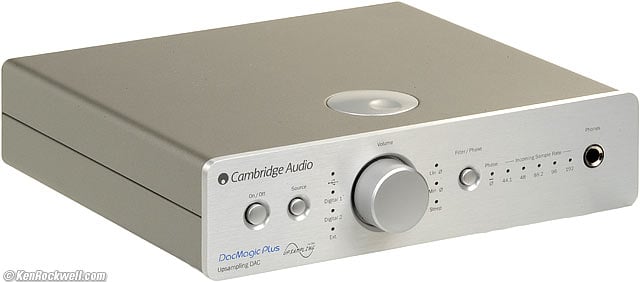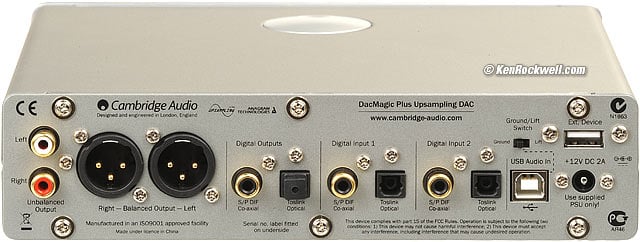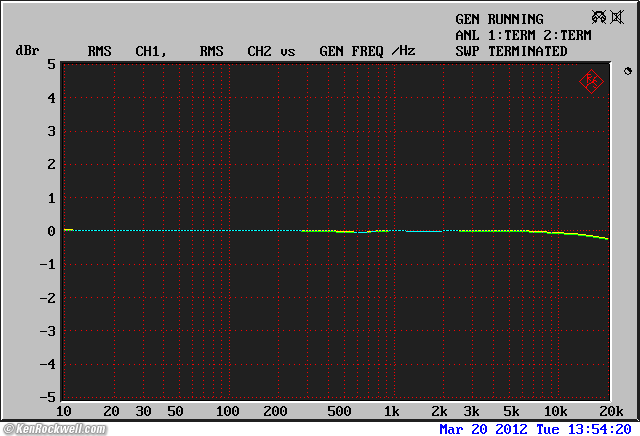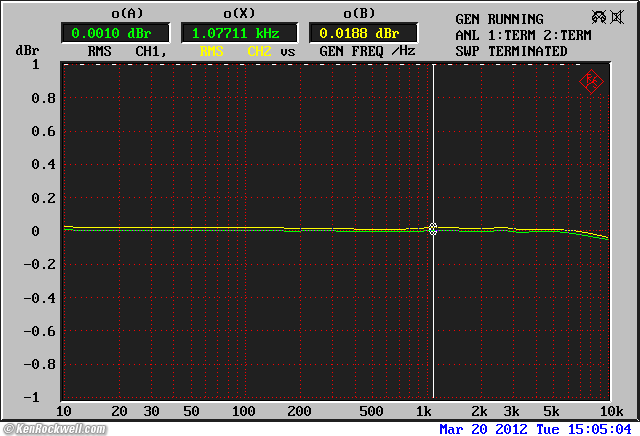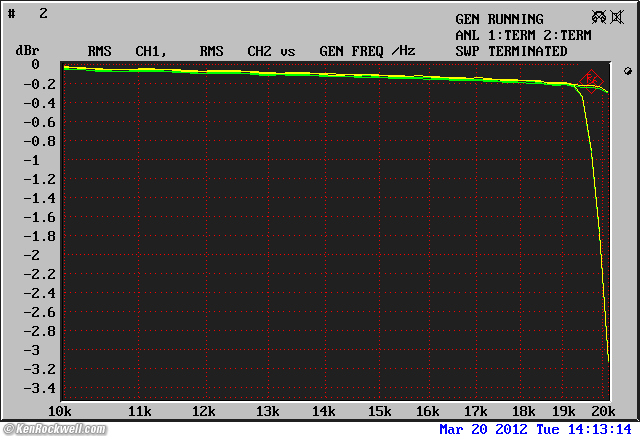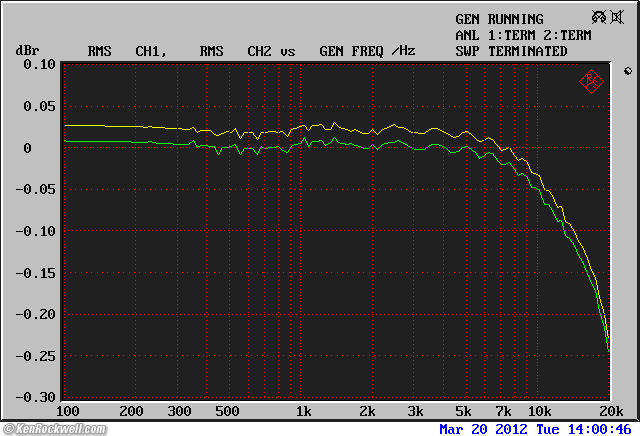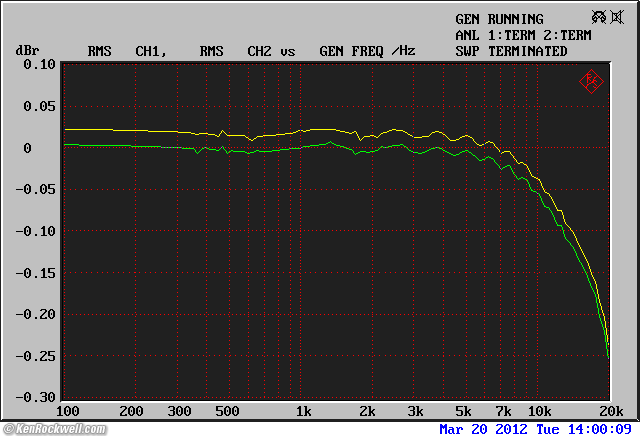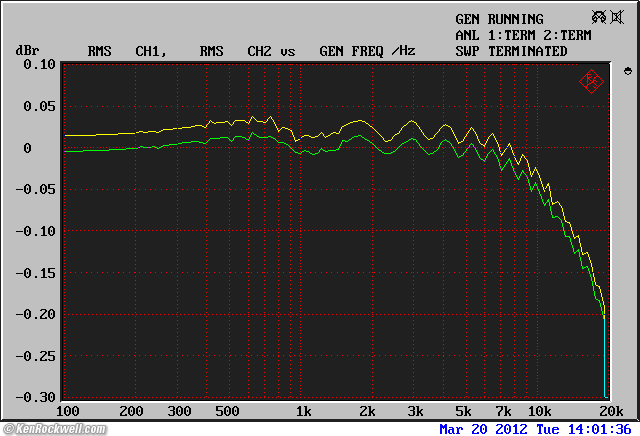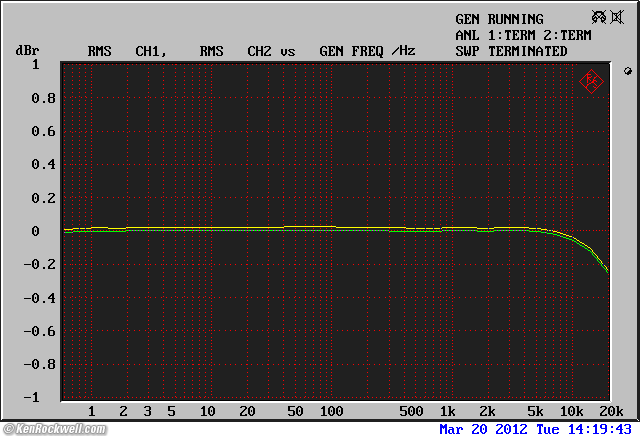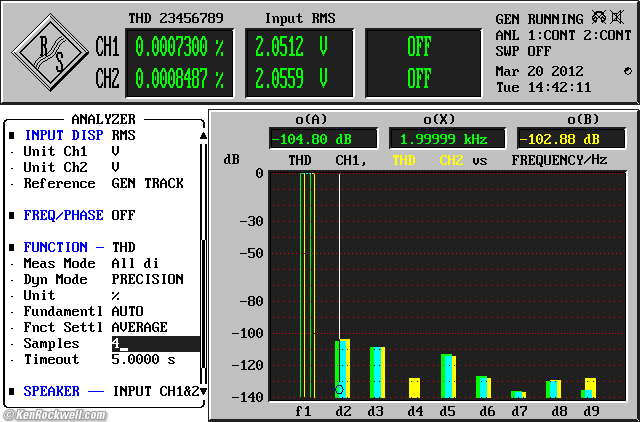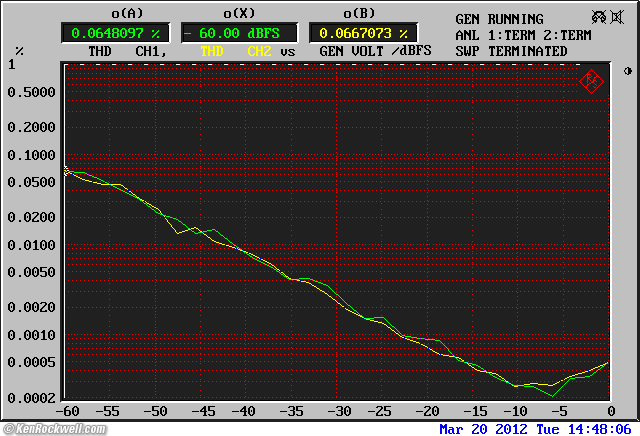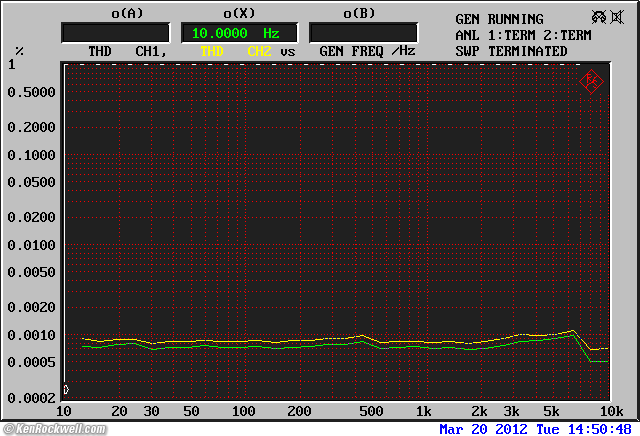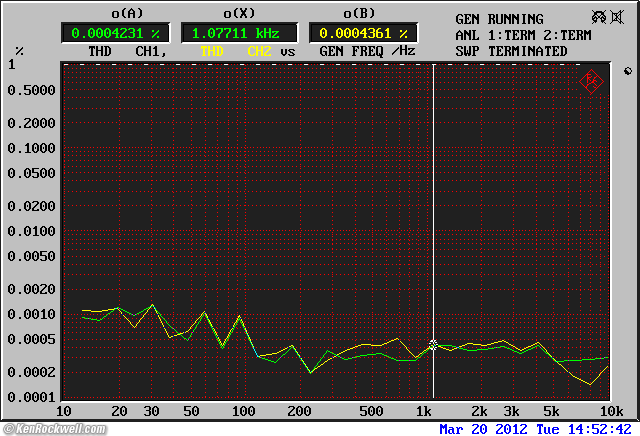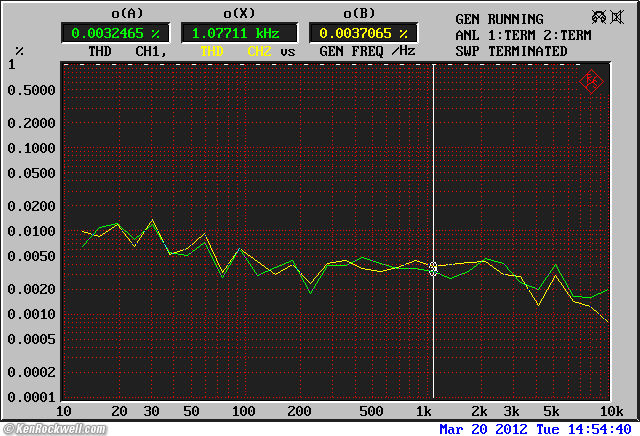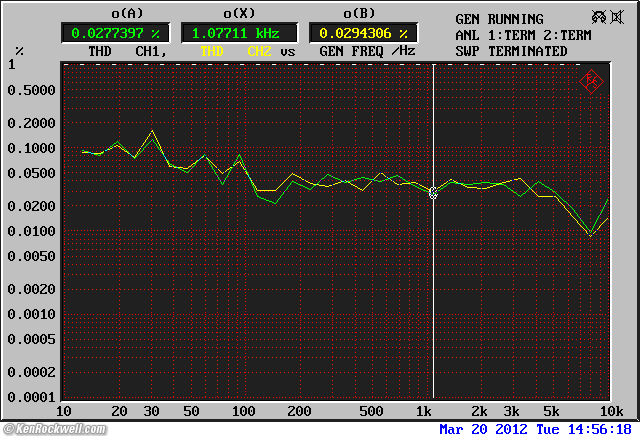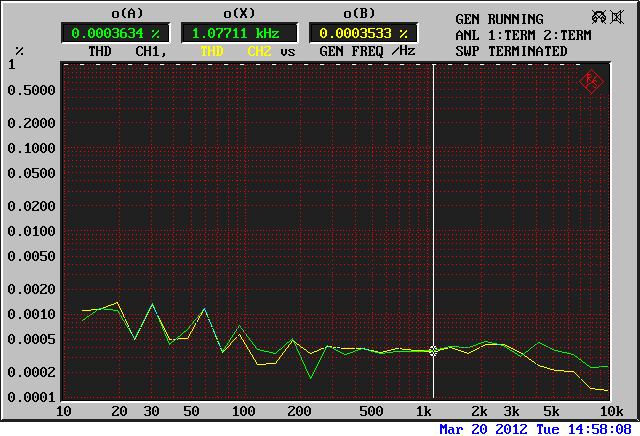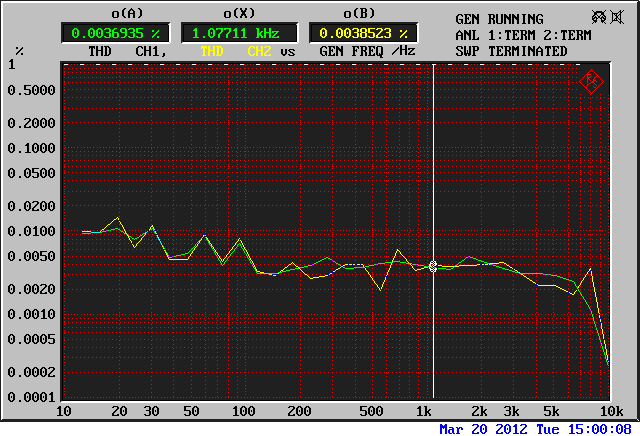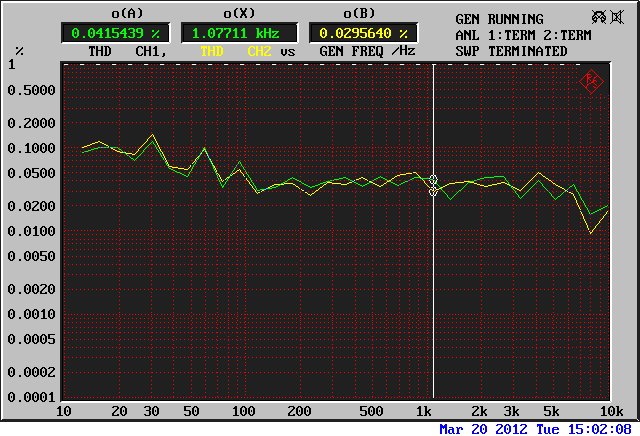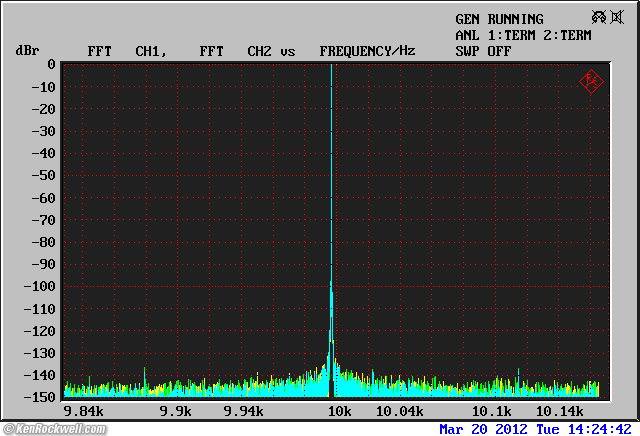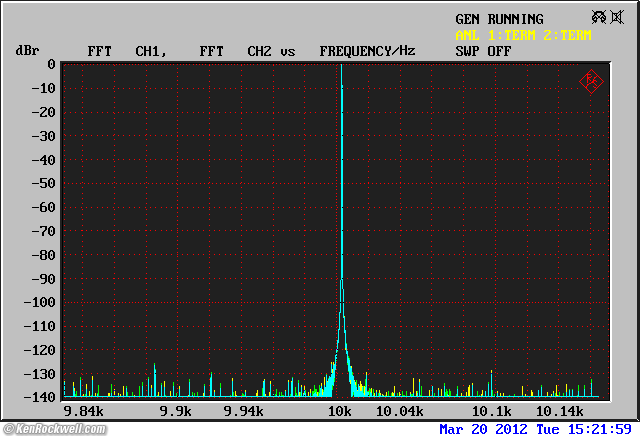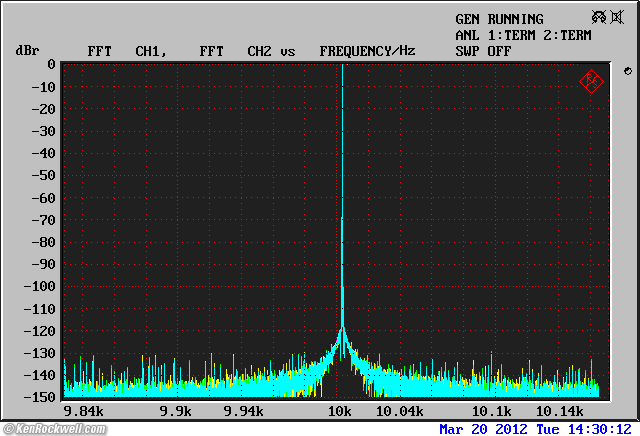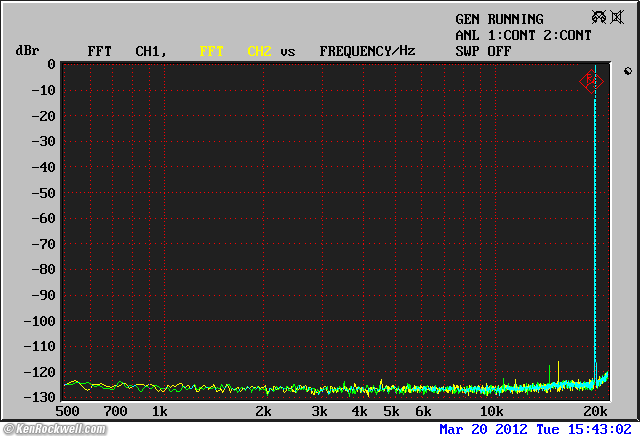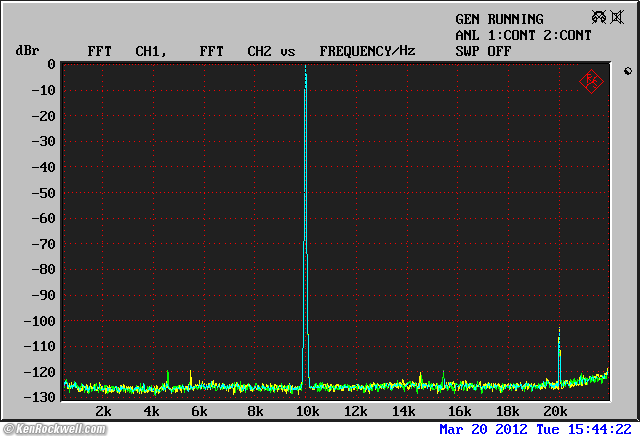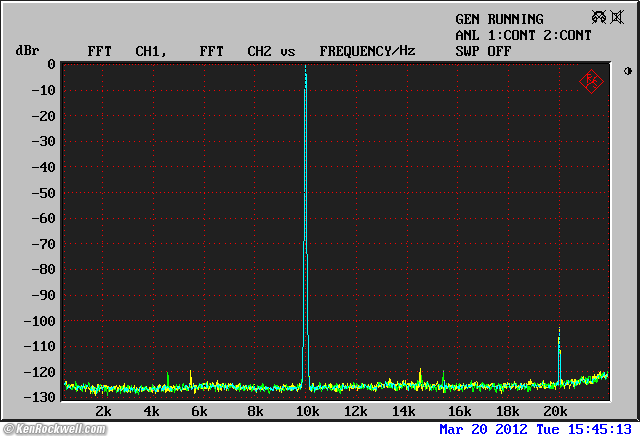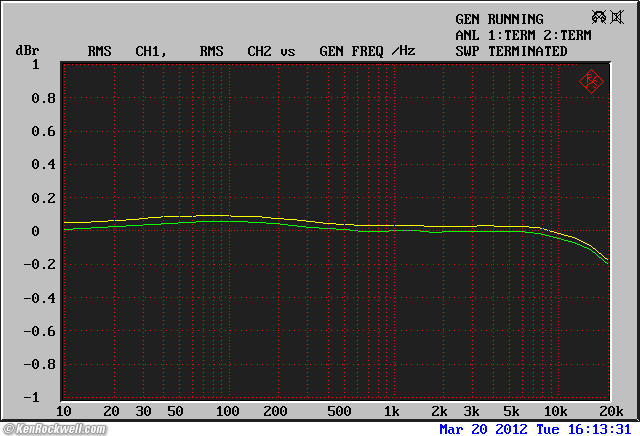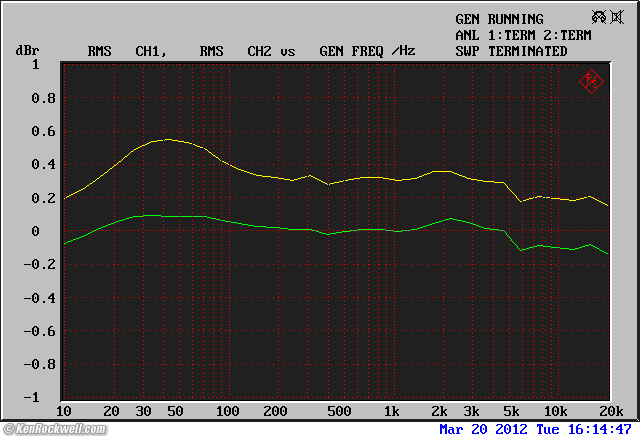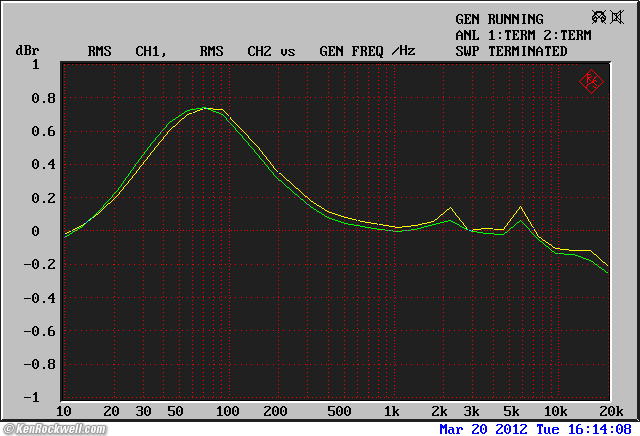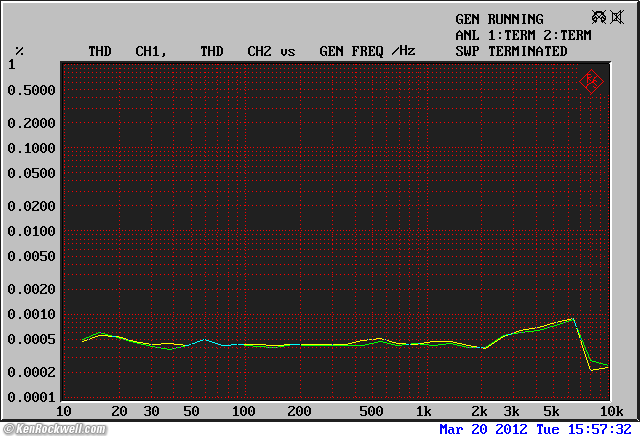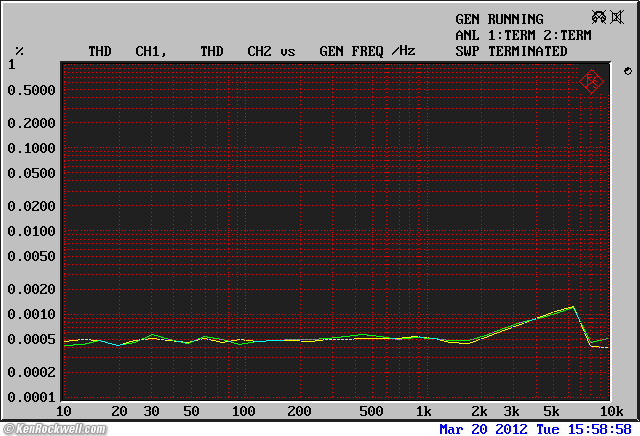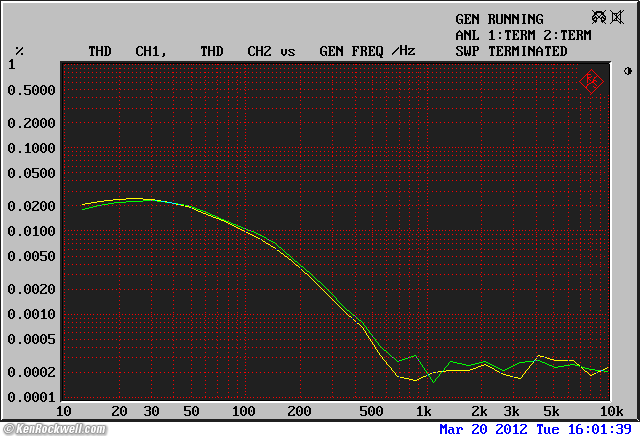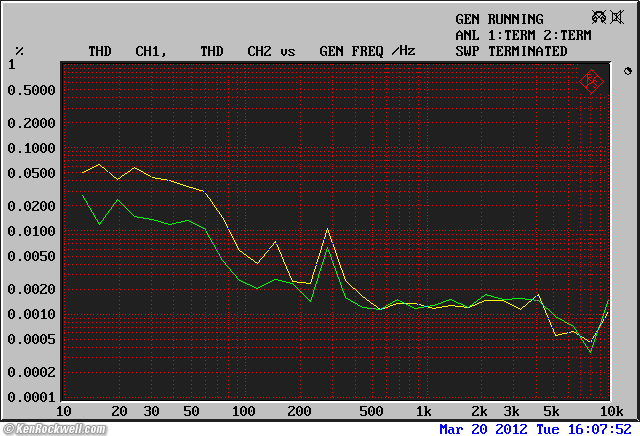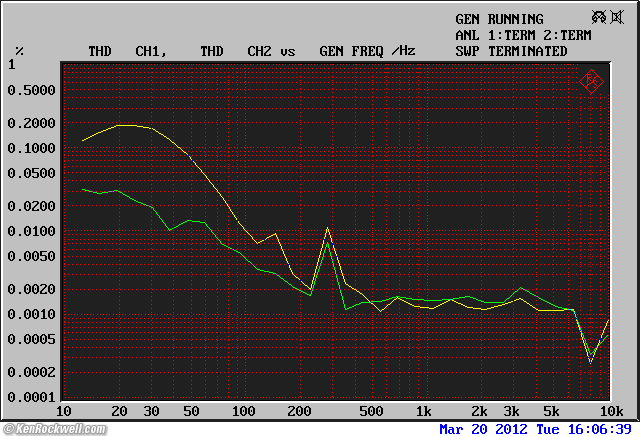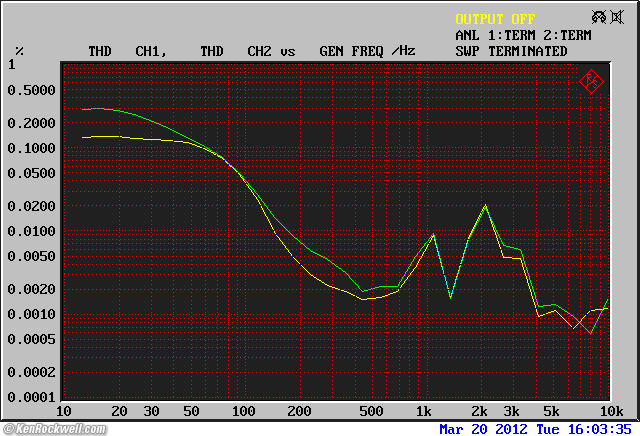Home Donate New Search Gallery Reviews How-To Books Links Workshops About Contact
Cambridge DacMagic Plus
192k/24b DAC and Semi-Preamp
© 2012 KenRockwell.com. All rights reserved.
Intro Specs Performance Measurements Usage Recommendations More
Cambridge Audio DacMagic Plus (2.8 lbs./1.3 kg, about $600). enlarge. This free website's biggest source of support is when you use these links, especially this link to them at Amazon, when you get anything, regardless of the country in which you live. Thanks! Ken.
Rear, Cambridge Audio DacMagic Plus. enlarge.
March 2012 All Reviews > Audio Reviews
Digital Inputs: USB, (2) TOSLINK or coaxial RCA digital inputs. Also a flat USB connector for a dedicated, optional BT100 bluetooth receiver.
Analog Outputs: Unbalanced RCA and balanced XLR. ¼" headphone jack.
Digital Outputs: TOSLINK and RCA (pass-through only).
Power: 12V wall-wart. 100-240V, 50-60 Hz, with three different power connectors for world-wide use.
Notable: Astounding technical DAC performance regardless of price. Absolute polarity switch. Three easily-selected digital filters. Headphone output.
Missing: No remote control. No analog inputs. No AES digital inputs or outputs. Not USB powered (always needs wall power). Balanced output 10 dB below standard +4 levels.
Introduction top
Intro Specs Performance Measurements Usage Recommendations More
|
Adorama pays top dollar for your used gear. I use Adorama, Amazon, eBay, Ritz, B&H, Calumet, J&R and ScanCafe. I can't vouch for ads below.
|
The Cambridge Audio DacMagic Plus is an inexpensive, lightweight, Chinese-made DAC with astounding performance.
It has the highest performance of any DAC I've ever measured, and is among the least expensive. It's not the biggest, toughest, heaviest or most-impressive looking, but nothing outperforms it sonically. It's also one of the few DACs at any price to include an absolute polarity switch, as well as digital filter options. Not bad for $600!
It only has digital inputs so it's not really a preamp, but it does have four selectable inputs, a volume control and even a headphone output, so for many of us, it can be our master control center.
It does not have a remote control.
It has the best performance I've ever measured over USB of any DAC at any price. It's completely immune to even the slightest jitter that other excellent DACs can't remove from USB, as well as often the best performances I've measured for distortion. I installed no software, and magically it fed itself with 96 ksps audio via USB from iTunes on my Mac.
Its headphone amplifier performance is typical, limited by its 50 Ω output source impedance, but at least it's 12 dB louder (4 V RMS max.) with high-impedance headphones than most iPods and portable equipment.
Specifications top
Intro Specs Performance Measurements Usage Recommendations More
Colors
Black or silver.
Inputs
Digital only.
16~24 bits.
32 ksps, 44.1 ksps, 48 ksps, 88.2 ksps, 96 ksps, 176.4 ksps, 192 ksps.
(1) USB, marked with the flipped pawn-shop symbol on front-panel.
(2) TOSLINK or RCA, marked as "Digital 1" and "Digital 2" on front-panel.
(1) Flat USB slot for the dedicated BT100 bluetooth receiver, marked "Ext" on front panel.
Technology
All digital inputs resampled to 384 ksps and 24-bits with Analog Devices ADSP21261 DSP.
Dual Wolfson WM8740 24-bit DACs.
Analog low-pass filter: 2-pole dual differential Bessel double virtual earth balanced.
Frequency Response
20 ~ 20,000 Hz ±0.1dB.
Headphone response is rated 10 ~ 100,000 Hz, without a tolerance, but it's unclear how you get it a 100 kHz signal if the maximum sample rate is 192 ksps.
THD
< 0.001 % at 1 kHz at 0 dBFS and -10 dBFS.
< 0.002 % at 20 kHz at 0 dBFS.
SNR
-112dBr.
Reference not stated, so this a meaningless spec.
Correlated Jitter
< 130 pS.
Outputs
Output Impedance
< 50 Ω.
RCA Unbalanced
2.1 V @ 0 dBFS.
Headphones
¼" headphone jack on front.
32 ~ 600 Ω headphones recommended.
XLR Balanced
4.2 V RMS @ 0 dBFS.
Digital
TOSLINK and RCA, simply pass-throughs of the selected input.
Power
12 V DC from supplied AC adapter.
Measured Power Consumption (from 120 VAC 60 Hz via AC adapter):
0.0 watts off.
8.0 watts on.
7.75 watts with headphones (line output mutes).
Size
2.0 x 8.6 x 7.6” HWD.
52 x 215 x 191mm HWD.
Weight
44.935 oz. (2.81 pounds, 1,273.9g), measured.
1.2kg/2.6lbs, rated.
Quality
Performance top
Intro Specs Performance Measurements Usage Recommendations More
The DacMagic Plus is a lightweight piece of consumer equipment that is sonically superb, although the slowly-responding volume control and its plastic knob is a real disappointment.
It's easy to get started: just plug it in. The only reason to read the manual is if you want to disable the volume control and have it run at full output all the time.
It's clean: what comes out is exactly what goes in; nothing more, nothing less.
It has no fans and makes no noise.
There is no audible self-noise from the headphone jacks, even with super-sensitive Audio-Technica ATH-M50 headphones at full gain.
Software and Installation
There is no software and no firmware: plug and play.
There might be some drivers for tweaks, I have no time to explore when there's so much great music to enjoy instead of tweaking.
Ergonomics & Usage top
Intro Specs Performance Measurements Usage Recommendations More
The biggest disappointment about the high-performance DacMagic Plus is its poky volume control. You have to keep turning and turning it to change the volume.
The volume control is too darn slow to respond. It's maddening to use.
With some music, like softer classical sections recorded with plenty of infrasonic room rumble, you may hear some "zipper noise" as you're changing the volume.
It turns and turns without stops. You never really know where the volume's set, except that the source LED blinks when you're all the way up or down.
You'll be spending a lot of time turning this knob, and it's plastic and not that deep, so grip isn't that wonderful.
Great news is that tapping it mutes and unmutes instantly.
It mutes the line outputs with a time-delay relay whenever headphones are inserted, a brilliant touch!
It unmutes when you tap the volume control, remove the headphones or change the filter selection.
It's shipped in a nice box with foam inserts. The DAC itself is in a nice reusable bag, adding a quality touch.
It always stays on, so if fed from a Mac, there are no power thumps since it's always on. If my Mac is sleeping and I turn on the DacMagic connected by USB, my Mac wakes.
The 4 V RMS headphone output is more than enough for sensitive, low-impedance headphones like the Audio-Technica ATH-M50, and usually enough with less sensitive 600 Ω headphones like the DT880.
Blue Lights
All the LEDs are blue, not amber.
They aren't very bright by day, and swell at night — except at night, you can't read the panel inscriptions.
The input LEDs blink if the input goes away, for instance, if your computer is asleep and your DacMagic is left on on your desk.
Mechanics
This Cambridge Audio DacMagic Plus is typical precise and lightweight Chinese: sheet metal case and aluminum front.
There are no bottom feet so you can install it in tight spots. If you want feet, stick-on bumpers are included for you to attach.
A plastic base is included for it to stand vertically, say, on your desk. If you use this, the front-panel lettering doesn't rotate.
Measurements top
Intro Specs Performance Measurements Usage Recommendations More
Output Levels Output Impedance Noise Channel Tracking
Frequency Response THD Output Spectra Low-Level Linearity
Jitter Rejection Headphone Output
These measurements were made with a $50,000 Rohde & Schwarz UPL laboratory analyzer. The traces from the Rohde & Schwarz UPL laboratory analyzer are color coded for the Left Channel and for the Right Channel. When they don't lie on top of each other, it's due to channel imbalance.
Even measured from 44.1/16-bit sources, this DAC is much cleaner than an excellent power amp. Most people have no idea how good is 44.1/16; even at 44.1/16, this will be the cleanest part of your reproduction chain.
All measurements are made with coaxial digital input from the UPL, linear phase filter, 44.1 ksps (kilosamples per second a.k.a. kHz), 24 undithered bits at 0 dBFS, maximum volume and unbalanced outputs at 2 V RMS, unless otherwise specified.
Output Levels (At maximum gain at 0 dBFS) measurements top
Unbalanced Output Level (200 kΩ load)
2.053 V RMS at 0.0007% THD:
Actual output source impedance at 1 kHz: 47.5 Ω.
Headphone Output Levels
Actual measured output source impedance at 1kHz: 33.2 Ω.
Headphone output at 0 dBFS
Load |
RMS @ THD |
200 kΩ |
4.04 V@ 0.00025% THD |
600 Ω |
3.84 V@ 0.00022% THD |
300 Ω |
3.64 V @ 0.00025% THD |
37.5 Ω |
2.15 V @ 0.00045% THD |
Balanced Output Levels
Actual output source impedance at 1 kHz: 94.6 Ω.
200 kΩ load:
4.093 V RMS at 0.00025% THD.
600 Ω load:
3.53 V RMS at 0.0003% THD.
Output Source Impedances measurements top
Unbalanced output
Source impedance at 1 kHz: 47.5 Ω.
Headphone output
Source impedance at 1kHz: 33.2 Ω.
Balanced output
Source impedance at 1 kHz: 94.6 Ω.
Noise measurements top
Unbalanced Output Noise
-107.4 dBV A-weighted (18.5 effective bits ref. 2 V RMS).
-103.9 dBV unweighted (18.0 effective bits ref. 2 V RMS).
Headphone Output Noise (600Ω load)
-102 dBV A-weighted.
-98 dBV unweighted.
Doesn't vary with volume control setting.
Inaudible even with sensitive Ultrasone Edition 8 or Sony MDR-7506 headphones.
Balanced Output Noise
-101.8 dBV A-weighted.
-97.9 dBV unweighted.
-113 dBV A-weighted when headphones mute output.
Channel Tracking measurements top
The channel matching and tracking is perfect to within hundredths of a dB, as expected from electronic control, and about a hundred times better than the $1,900 Benchmark DAC1 HDR.
Frequency Response measurements top
Frequency response is flat.
Cambridge Audio DacMagic Plus frequency response. (R&S UPL source.)
Let's change the scale on the analyzer and change the volume control to see if anything changes:
Frequency response at 0 dBFS and -60 dB gain (2mV output). (R&S UPL source.)
Good: frequency response doesn't vary with volume control setting.
Let's see what the filters do:
"Lin. ∅" and "Min. ∅" top, "Steep" below , 10,000 - 20,150 Hz. (R&S UPL source.)
"Lin. ∅" and "Min. ∅"have the same response. "Steep" is a few dB off at 20 kHz, but still flat to beyond 19 kHz.
Normal people can stop reading here, but I'm going to crank up the scale on the analyzer and see what I can see with these different filters:
"Lin. ∅" frequency response, expanded scale. (R&S UPL source.)
"Min. ∅" frequency response, expanded scale. (R&S UPL source.)
"Lin. ∅" frequency response, expanded scale. (R&S UPL source.)
No big deal.
Let's look at infrasonics:
"Lin. ∅"Infrasonic frequency response, expanded scale. (R&S UPL source.)
Still flat even below 1 Hz. It's flat to within +0, -0.2 dB from infrasonics to the end of the music band, which is great. That 0.2 dB at 20 kHz is probably from cable capacitance and the 50 Ω output source impedance of the DacMagic Plus.
THD: 0.0008% (-102 dB) measurements top
Harmonic components, unbalanced output at maximum gain, 1kHz at 0 dBFS. (R&S UPL source.)
THD versus level from -60 dBFS to 0 dBFS, unbalanced output at maximum variable gain, undithered 24-bit 44.1 ksps input, 22kHz bandwidth. (R&S UPL.)
THD versus frequency at 0 dBFS, maximum 2 V RMS output, 22kHz bandwidth. (R&S UPL.)
THD versus frequency at -20 dBFS, maximum 200 mV RMS output, 22kHz bandwidth. (R&S UPL.)
THD versus frequency at -40 dBFS, maximum 20 mV RMS output, 22kHz bandwidth. (R&S UPL.)
THD versus frequency at -60 dBFS, maximum 2 mV RMS output, 22kHz bandwidth. (R&S UPL.)
Marvelous; this is still a fraction of a tube amp's distortion, even at -60 dBFS.
Now let's see if the volume control introduces any distortion:
THD versus frequency at 0 dBFS, -20 dB gain, 200 mV RMS output, 22kHz bandwidth. (R&S UPL.)
THD versus frequency at 0 dBFS, -40 dB gain, 20 mV RMS output, 22kHz bandwidth. (R&S UPL.)
THD versus frequency at 0 dBFS, -60 dB gain, 2 mV RMS output, 22kHz bandwidth. (R&S UPL.)
No problems here; for all I know, this could just be noise. It measures the same as reducing the digital input level.
Good! Look at the distortion of the $1,900 Benchmark DAC1 HDR and see if you see any differences.
Output Spectra measurements top
10 kHz Sine Wave, Narrowband FFT (Jitter test)
RCA coaxial digital input from R&S UPL.
Beautiful; this is as clean as a state-of-the-art laboratory generator, and as good as the state-of-the-art Benchmark DAC1 HDR.
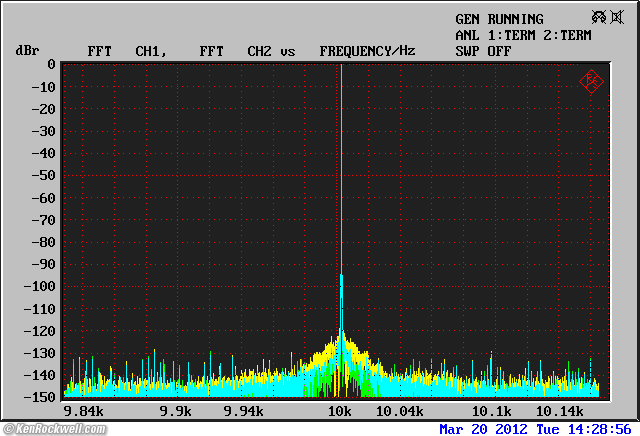
TOSLINK input from MacPro playing ALC file in iTunes 10.6 from CBS CD-1 track 9.
Again, beautiful.
Let's see how a crappy old DVD changer looks playing the test CD directly:
RCA coaxial digital input fed from Sony DVP-NC85H DVD changer playing CBS CD-1 track 9 via a 4-meter (13 foot, 240 pF) RCA cable.
Goodness, this is excellent: almost no jitter (spreading of the main spike) and no spurs above -126 dBFS.Here is is again from my Mac playing-out from iTunes, by USB this time, the worst possible interface:
USB input from MacPro playing ALC file in iTunes 10.6 from CBS CD-1 track 9.
Perfect! The DAC1 HDR has more jitter (spreading of the main spike) from USB. Either is just about perfect; what jitter I can show in a laboratory for these isn't at all audible, but audiophiles worry themselves sick about things they can't actually hear.
This is worst-case USB: I fed a 7-way Belkin hub from my MacPro, and then ran a 6 foot crappy USB cable to the DacMagic Plus, for a total of about 12 feet of 10-year-old USB cable.
Compare to Sony SCD-XA777ES, Benchmark DAC1 HDR, Apogee Duet 2 and audioengine D2.
11 kHz + 12 kHz IMD
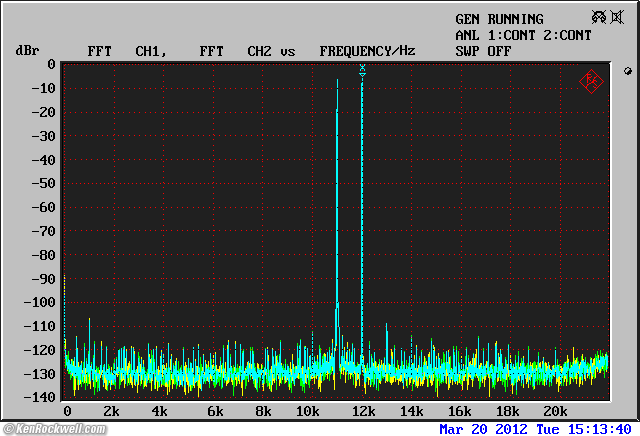
USB input from MacPro playing ALC file in iTunes 10.6 from CBS CD-1 track 13, Index 2.
Excellent, I've never tested better, and more expensive DACs have been worse! I also tested directly from the DVD changer via RCA and from the MacPro via TOSLINK, and they were the same, so I didn't bother to show them here. This is superb performance.
Compare to Sony SCD-XA777ES, audioengine D2 , Benchmark DAC1 HDR and Apogee Duet 2.
1,002.27 Hz Square Wave (overshoot headroom test)
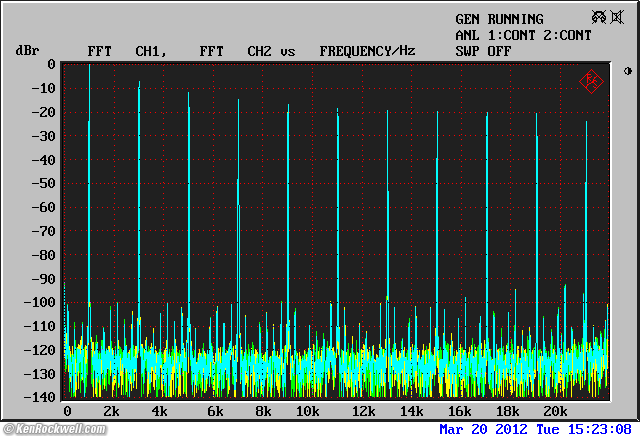
RCA coaxial digital input fed from Sony DVP-NC85H DVD changer playing CBS CD-1 track 16 via a 4-meter (13 foot, 240 pF) RCA cable.
This is very good, and better than many other DACs, and about as good as onboard CD player DACs. (onboard DACs are usually better at handling overshoots than computer-fed DACs because external DACs seem to have forgotten about DSP headroom.)
From a 1 kHz square wave, there should be strong harmonics at every odd kHz (3 kHz, 5 kHz, 7 kHz, 9 kHz etc.) and none of the crud in between. Most outboard DAC DSP lacks the headroom to deal with bonehead test signals like this that represent levels above 0 dBFS and therefore clip the transient overshoots, leading to all the extra spurs.
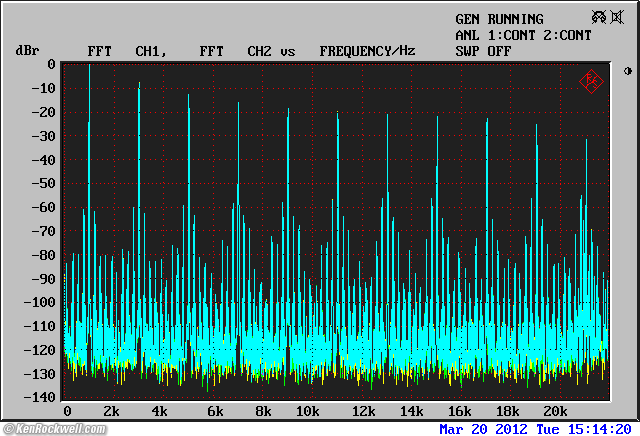
USB input from MacPro playing ALC file in iTunes 10.6 from CBS CD-1 track 16.
Not that great from USB, but reducing the playback level a click or two in iTunes cleared it right up.
Compare to the Sony SCD-XA777ES, audioengine D2, Apogee Duet 2, and Benchmark DAC1 HDR.
Low-Level Linearity: Superb measurements top
The Cambridge Audio DacMagic Plus is the most linear DAC I've ever tested, better than the Benchmark DAC1 HDR.
Look at this: perfect down to -120 dBFS, with an undithered 24-bit signal:
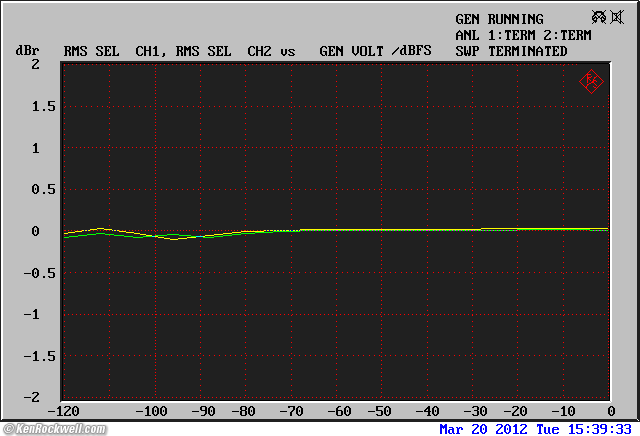
1 kHz level error versus digital modulation level, -120 ~ 0 dBFS, undithered 24-bit 44.1 ksps input. (R&S UPL.)
Jitter Rejection: Superb measurements top
20 kHz signal with 0.1 UI of jitter added at 19 kHz, 44.1 ksps RCA input from R&S UPL.
This is perfect. If jitter was affecting the audio output, you'd see a spike at 1 kHz. The tits around 15kHz were there with or without jitter; I didn't bother to track down their source.
10 kHz signal with 0.1 UI of jitter added at 19 kHz, 44.1 ksps RCA input from R&S UPL.
Again, this is perfect. If jitter was affecting the audio output, you'd see it as a spikes at 1 kHz intervals, which we don't. The tits around 5kHz and 15kHz were there with or without jitter; I didn't bother to track down their source. The 20 kHz tit is simple second-harmonic distortion that also was there with or without jitter.
10 kHz signal with 0.25 UI of jitter added at 1 kHz, 44.1 ksps RCA input from R&S UPL.
Again, complete immunity from jitter. The tits around 5 kHz and 15 kHz aren't related to jitter.
Headphone Output measurements top
Output source impedance at 1kHz: 33.2 Ω.
Headphone Frequency Response
Driving a resistor, it's the same as the line outputs, so I won't bother printing them here again.
Let's see how it does driving real headphones:
Headphone output driving 600 Ω Beyer DT880. (R&S UPL.)
Headphone response is flatter than most people could measure. The difference between channels is channel imbalance.
Headphone output driving Audio-Technica ATH-M50. (R&S UPL.)
This is swell. A half dB at 42 Hz never killed anyone's mix.
Aha! The channel imbalance is from a slight variation in the headphone's drivers, not the DacMagic Plus.
Headphone output driving Ultrasone Edition 8. (R&S UPL.)
An 0.7 dB bump is typical for an amplifier with a 50 Ω output source impedance. It's the reason you buy a Benchmark DAC1 HDR if you don't want this to happen. Likewise, the peaks at 2kHz and 6kHz are from peaks in the Ultrasone Edition 8's impedance.
Headphone THD
It's perfectly happy driving resistors:
Headphone output THD at 1 V RMS driving 600 Ω resistor. (R&S UPL.)
Headphone output THD at 100 mV RMS driving 37.5 Ω resistor. (R&S UPL.)
Magnificent.
Let's plug in headphones and see what matters:
Headphone output THD driving Beyer DT 880 (600Ω version) at 1 V RMS. (R&S UPL.)
Aha! The 50 Ω output source impedance leads to the added low-frequency distortion. At 0.02%, forget about it.
Headphone output THD driving Audio-Technica ATH-M50 on-head at 100 mV RMS. (R&S UPL.)
Headphone output THD driving Audio-Technica ATH-M50 off-head at 100 mV RMS. (R&S UPL.)
Aha! The impedance of any driver changes with its acoustic loading, meaning headphones present different loads if on or off your head. When off-head, the ATH-M50 leads to more distortion with the Cambridge DacMagic Plus.
Headphone output THD driving Ultrasone Edition 8 at 100 mV RMS, TOSLINK input. (R&S UPL.)
Hmm, 0.2% distortion isn't good, but probably not audible. The Benchmark DAC1 HDR is much, much better here if you want a great, accurate headphone amplifier and DAC.
Usage top
Intro Specs Performance Compared Usage Recommendations More
The digital outputs are not affected by the resampling, volume or filter controls. They simply pass-through the selected input. They are handy for feeding to your DAT machine or Tek 764 digital audio monitor.
Read the Users Manual to disable the volume control; as I recall it's done by holding one button while turning it on.
Recommendations top
Intro Specs Performance Measurements Usage Recommendations More
The Cambridge Audio DacMagic Plus is an extremely high-performance DAC, with performance unsurpassed at any price. It also has the best jitter immunity I've ever measured, and this is from any of its inputs.
Its volume control is a pain, but for the price, I'll deal with it.
I can't think of any DAC at any price that is better for use in a fixed installation where you don't need a volume control or remote control. That leads to another suggestion: the new Cambridge Audio Azur DacMagic 100 is a simplified version without the volume control, headphone jack, upsampling or filter and polarity controls, for close to half the price.
Like most good DACs, the DacMagic Plus only plays PCM, not any of the fluff formats like Dolby Digital or DTS & etc.
If you've found the days I invested auditioning the DacMagic Plus (and laboratory testing at even greater expense) helpful, this free website's biggest source of support is when you use these links, especially this link to them at Amazon, when you get anything, regardless of the country in which you live.
Thanks!
Ken.
More Information top
Intro Specs Performance Measurements Usage Recommendations More
Cambridge Audio's DacMagic Plus users manual.
Cambridge Audio's DacMagic Plus information page.
Help me help you top
I support my growing family through this website, as crazy as it might seem.
If you find this page as helpful as a book you might have had to buy or a workshop you may have had to take, feel free to help me continue helping everyone.
If you've gotten your gear through one of my links or helped otherwise, you're family. It's great people like you who allow me to keep adding to this site full-time. Thanks!
If you haven't helped yet, please do, and consider helping me with a gift of $5.00.
As this page is copyrighted and formally registered, it is unlawful to make copies, especially in the form of printouts for personal use. If you wish to make a printout for personal use, you are granted one-time permission only if you PayPal me $5.00 per printout or part thereof. Thank you!
Thanks for reading!
Mr. & Mrs. Ken Rockwell, Ryan and Katie.
Home Donate New Search Gallery Reviews How-To Books Links Workshops About Contact

